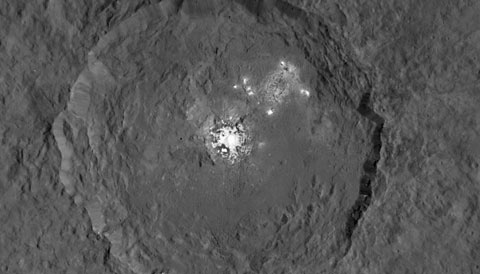The bright spots in Ceres’ crater Occator are the gift that keeps on giving. Check out this latest composite image from NASA’s Dawn spacecraft. I mean, wow.

Credit: NASA / JPL-Caltech / UCLA / MPS / DLR / IDA
The team created this composite from images taken from the spacecraft's high-altitude mapping orbit (1,470 km, or 915 miles, above the asteroid’s surface). The image combines two different ones: a short-exposure shot to capture the bright spots’ details, and a regular one for the background surface. That’s necessary because the spots’ brightness is blinding: their albedo is about 50%, meaning they reflect 50% of the light that hits them. Compare that with the surrounding terrain’s albedo of about 4% to 7%, and you can see why longer exposures geared to studying the asteroid’s regular surface overexpose the spots (like the one from earlier this summer).
The central spot’s splayed-out structure raises a lot of questions about why it looks that way. But mission principal investigator Christopher Russell (UCLA) cautions that we shouldn’t jump to any conclusions using this latest view. Although the team has taken very careful exposures, those with the background clearly visible might have some saturation, he says. So we can’t say for sure that the shapes we’re seeing are definitely what are on the ground. We’ll have to wait for the lowest mapping orbit — only 375 km, or 230 miles, above the surface — to know for sure. That’s also when Dawn’s spectrometer will be able to home in on the spots and reveal what they’re made of. (You can add your vote to the mission’s running poll.)
Below, you can watch a simulated flyover of Occator. Credit: NASA / JPL-Caltech / UCLA / MPS / DLR / IDA / PSI. And check out NASA's press release for more information.
Read all about the Dawn mission in our April 2015 issue.
 4
4









Comments
Darian-Rachal
September 11, 2015 at 11:00 am
Are these areas really this bright or is this just an area that is lighter in contrast to their background, i.e. have the areas been enhanced to show the contrast or is this essentially a 'naked eye' view of the area?
You must be logged in to post a comment.
Peter Wilson
September 15, 2015 at 1:37 pm
The caption reads: This composite image combines two shots: a short exposure for the spots, and a longer exposure for the darker surface.
That means they have done the reverse of what your are suggesting; the "real" brightness is greater than the photos suggest. It is hard to say what a ‘naked eye view' is, because your brain does its own contrast enhancement. For example, you don't see the difference between sun-lit areas and shadow that a camera records.
You must be logged in to post a comment.
Jeff-Davis
September 11, 2015 at 10:50 pm
Permit me to ask a really stupid question: has this crater been imaged while facing away from the Sun? Does it only shine from reflected light or is it glowing based on some internal energy?
You must be logged in to post a comment.
September 15, 2015 at 2:29 am
Does anyone know the date "for the lowest mapping orbit — only 375 km, or 230 miles, above the surface" ..?
You must be logged in to post a comment.
You must be logged in to post a comment.